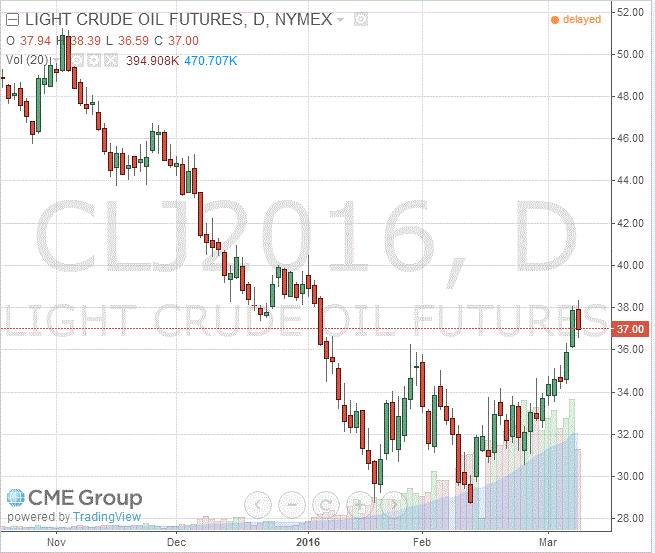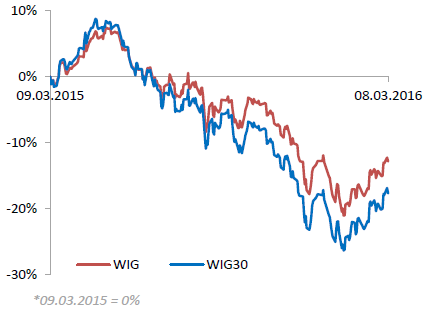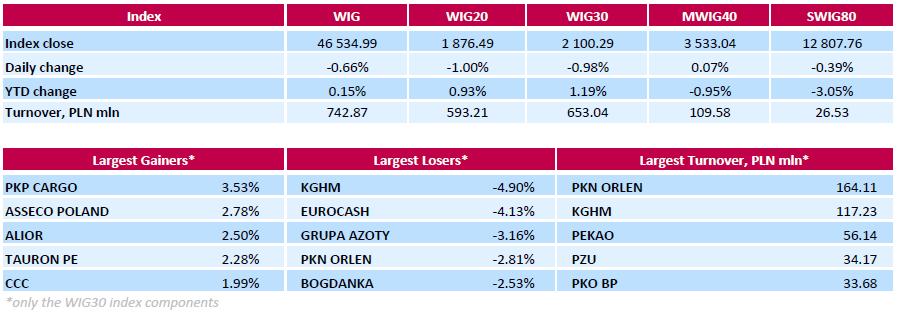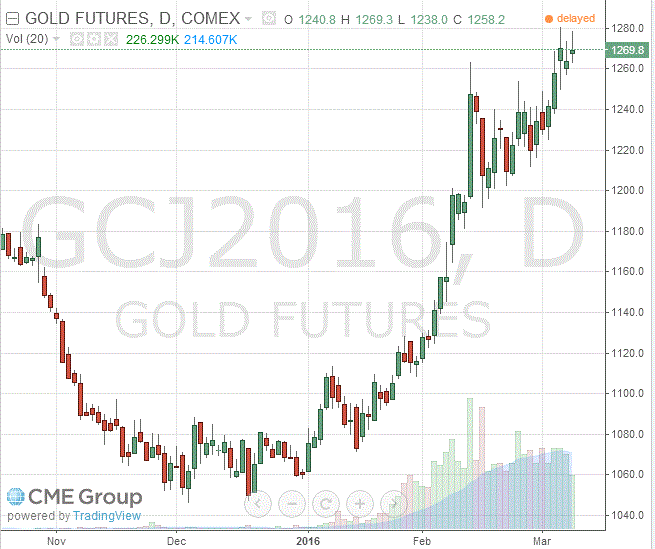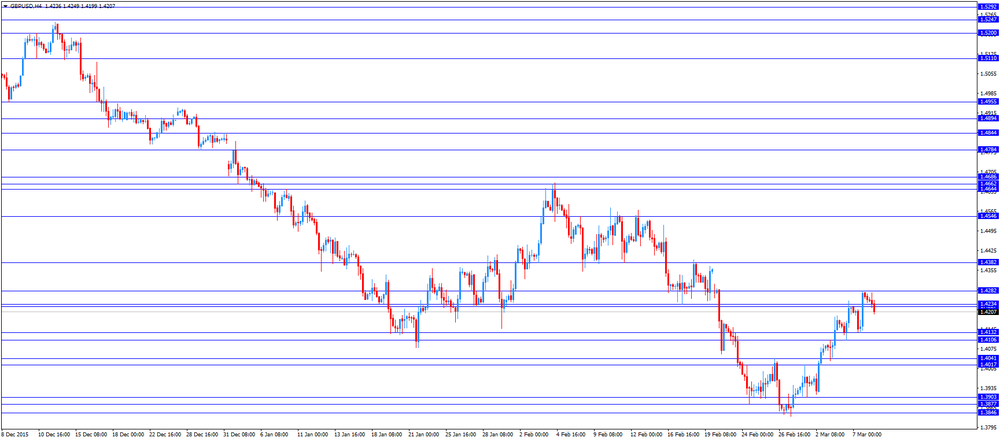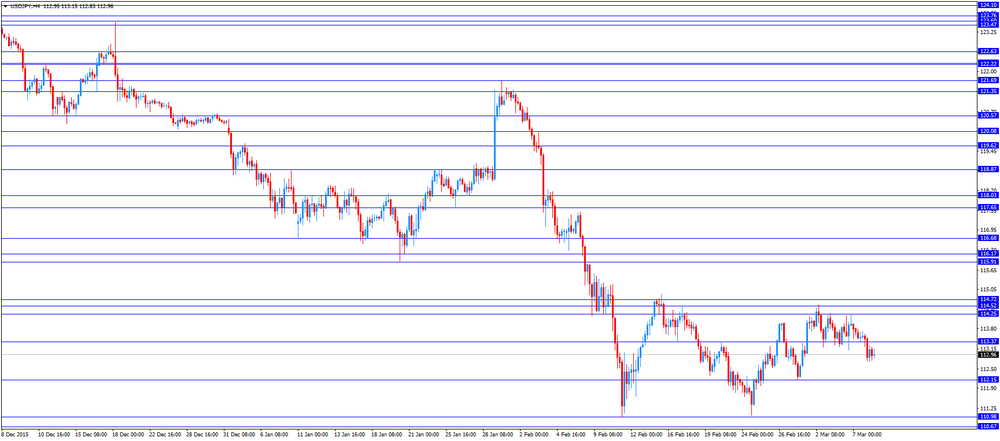Noticias del mercado
-
23:59
Schedule for today, Wednesday, Mar 9’2016:
(time / country / index / period / previous value / forecast)
00:30 Australia Home Loans January 2.6% -2.3%
06:00 Japan Prelim Machine Tool Orders, y/y February -17.2%
09:30 United Kingdom Industrial Production (MoM) January -1.1% 0.5%
09:30 United Kingdom Industrial Production (YoY) January -0.4% 0.2%
09:30 United Kingdom Manufacturing Production (MoM) January -0.2% 0.2%
09:30 United Kingdom Manufacturing Production (YoY) January -1.7% -0.7%
12:00 U.S. MBA Mortgage Applications March -4.8%
15:00 United Kingdom NIESR GDP Estimate February 0.4%
15:00 Canada Bank of Canada Rate 0.5% 0.5%
15:00 Canada BOC Rate Statement
15:00 U.S. Wholesale Inventories January -0.1% -0.2%
15:30 U.S. Crude Oil Inventories March 10.374
20:00 New Zealand RBNZ Interest Rate Decision 2.5% 2.5%
20:00 New Zealand RBNZ Rate Statement
20:05 New Zealand RBNZ Press Conference
23:10 New Zealand RBNZ Governor Graeme Wheeler Speaks
-
21:00
Dow -0.35% 17,013.61 -60.34 Nasdaq -0.78% 4,671.71 -36.54 S&P -0.73% 1,987.16 -14.60
-
20:20
American focus: The US dollar fell against major currencies
The euro lost ground against the previously-earned dollar, and returned to the level of opening of the session. The pressure on the currency has investors' anxiety before the meeting of the European Central Bank, which will take place on Thursday. Experts point out that there is likelihood of recurrence of the events of December, when the measures taken by the ECB fell short of market expectations.
The survey of 48 economists conducted by Bloomberg from 26 February to 3 March, showed that the ECB will extend the program to stimulate the economy. 98% predict that the ECB will take further steps to revive the economy and inflation. All of these 98% of respondents expect a rate cut on deposits, and nearly three-quarters - of the monthly increase in the volume of bond redemption. The median forecast shows that the ECB deposit rate will be reduced by 0.10% to 0.4%, and the volume of assets of the program (QE) will be increased to 75 billion. Euros per month from the current 60 billion. Euro. At the same time 72% of respondents do not expect new measures of quantitative easing since March, and 60% do not expect further reduction of interest rates on deposits after the meeting.
Market participants also continue to analyze today's data for the euro area, which showed that the economy grew, according to preliminary estimates, in the fourth quarter. GDP grew by 0.3 percent sequentially, according to estimates published on 12 February. The economy showed a similar expansion of 0.3 percent in the third quarter. In annual terms, GDP growth remained stable at 1.6 percent in the fourth quarter. The annual growth rate has been revised from 1.5 percent. A breakdown of the expenditure side of GDP shows that the growth of household expenditures fell to 0.2 percent from 0.5 percent sequentially. At the same time, the growth of government spending accelerated in half to 0.6 percent from 0.3 percent. In addition, investments increased by 1.3 percent, faster than the growth of 0.4 percent quarter ago. Export growth remained at 0.2 per cent, while imports rose 0.9 percent after rising 1.2 percent in the previous quarter.
The pound retreated from session low against the dollar, but still shows a moderate decrease. Initially, the currency decline was caused by the comments of the Bank of England Governor Mark Carney. He noted that the new agreement between the UK and the EU should contribute to the achievement of two objectives: maintaining low and stable inflation and maintaining financial stability. Reached by Prime Minister Cameron of the country in late February agreement touches on some important aspects of economic governance in the EU, the Bank of England believes that it is important to achieve the goals. In particular, the agreement makes it clear that for the management of the UK financial system meets the Bank of England and other governing bodies of the country.
Support for the pound had statements of the Bank of England representative Huila. He said that the next step is likely to be a rate hike, but added that there is scope for policy easing if necessary. "The Bank of England may expand asset purchases and reduce the rate if necessary also the Bank of England may start buying the assets of the private sector where appropriate.", - The politician said.
According to Reuters latest survey, the Bank of England will not raise interest rates before the beginning of 2017. It is worth emphasizing, since the beginning of this year, experts push back deadlines rate hike for the third time. None of the 59 economists polled this week, does not expect any change in rates at the next meeting of the Monetary Policy Committee of the Bank of England, which is scheduled for 17 March. The survey revealed that on average there is a 45 percent chance of growth rates by the end of this year. In late January, the probability was 55 percent. Meanwhile, the chances of a rate hike have increased to 75 percent by the end of next year. Analysts expect that by the end of next year the rate will be at 1.25 percent and then rise to 1.75 per cent until the end of 2018.
The Canadian dollar fell considerably against the US dollar, updating yesterday's low, which was associated with the publication of mixed statistics on Canada, as well as the resumption of decline in oil prices. The Canadian Mortgage and Housing Corporation (CMHC) reported that the number of new foundations bookmarks in Canada has increased from a seasonally adjusted annual rate of up to 212,594 units in February, compared to 165,071 units in January. The January figure was revised down from 165 900 units. The growing number of new foundations favorites was caused by an increase in single and multi-element segments. Meanwhile, Statistics Canada said that building permits in Canada fell 9.8% in January, losing to fall on expectations of 2.0%, after rising 7.7% in December. The December figure was revised from + 11.3%. The decline was due to the fall of permits for residential construction in British Columbia and Ontario.
-
18:52
Wall Street. Major U.S. stock-indexes fell
Major U.S. stock-indexes lower on Tuesday as oil prices tumbled and weak Chinese data rekindled fears of a global economic slowdown led by the world's second-biggest economy. China's February trade performance was far worse than economists had expected, with exports tumbling the most in over six years. The report weighed on markets worldwide. Oil prices fell nearly 3% in volatile trading.
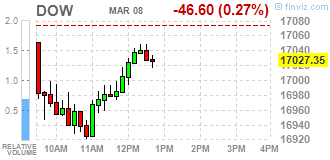
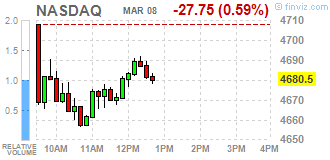
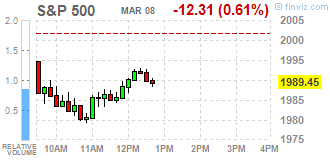
Most of Dow stocks in negative area (18 of 30). Top looser - Caterpillar Inc. (CAT, -2,97%). Top gainer - NIKE, Inc. (NKE, +2,08%).
Almost all of S&P sectors in negative area. Top looser - Basic Materials (-3,1%). Top gainer - Utilities (+0,5%).
At the moment:
Dow 17016.00 -32.00 -0.19%
S&P 500 1987.75 -11.25 -0.56%
Nasdaq 100 4294.75 -5.25 -0.12%
Oil 36.66 -1.24 -3.27%
Gold 1266.90 +2.90 +0.23%
U.S. 10yr 1.82 -0.08
-
18:00
European stocks closed: FTSE 100 6,125.44 -56.96 -0.92% CAC 40 4,404.02 -38.27 -0.86% DAX 9,692.82 -86.11 -0.88%
-
18:00
European stocks close: stocks closed lower on the Chinese trade data
Stock indices closed lower on the weaker-than-expected Chinese trade data. The Chinese Customs Office released its trade data on Tuesday. China's trade surplus dropped to $32.59 billion in February from $63.30 billion in January, beating expectations for a decline to a surplus of $50.15 billion. Exports fell at an annual rate of 25.4% in February, the biggest drop since May 2009, while imports slid at an annual rate of 13.8%, the fifteenth consecutive decline.
Falling oil prices also weighed on stocks. Oil prices declined as hopes for the freeze of the oil production seemed to disappear.
Market participants also eyed the economic data from the Eurozone. Eurostat released its revised gross domestic product (GDP) data for the Eurozone on Tuesday. Eurozone's revised GDP rose 0.3% in fourth quarter, in line with the preliminary reading, after a 0.3% gain in the third quarter.
On a yearly basis, Eurozone's revised gross domestic product (GDP) increased 1.6% in fourth quarter, up from the preliminary reading of 1.5%, after a 1.6% rise in the third quarter.
Household spending gained 0.2% in the fourth quarter, while gross fixed capital formation climbed 1.3%.
Exports climbed by 0.2% in the fourth quarter, while imports rose by 0.9%.
In 2015 as whole, GDP increased 1.6%, up from the preliminary reading of 1.5%, after a 0.9% growth in 2014.
Destatis released its industrial production data for Germany on Tuesday. German industrial production jumped 3.3% in January, exceeding expectations for a 0.5% gain, after a 0.3% decline in December.
Bank of England (BoE) Governor Mark Carney said before Treasury Select Committee on Tuesday that a deal to keep Britain in the EU (European Union) was important for UK's monetary and financial stability.
Indexes on the close:
Name Price Change Change %
FTSE 100 6,125.44 -56.96 -0.92 %
DAX 9,692.82 -86.11 -0.88 %
CAC 40 4,404.02 -38.27 -0.86 %
-
17:55
Oil prices decline as hopes for the freeze of the oil production seems to disappear
Oil prices declined as hopes for the freeze of the oil production seemed to disappear. Kuwait's oil minister, Anas al-Saleh, said on Tuesday that Kuwait would agree to freeze the oil output only if all major oil producers, including Iran, participate.
The Chinese trade data also weighed on oil prices. The Chinese Customs Office released its trade data on Tuesday. China's trade surplus dropped to $32.59 billion in February from $63.30 billion in January, beating expectations for a decline to a surplus of $50.15 billion. Exports fell at an annual rate of 25.4% in February, the biggest drop since May 2009, while imports slid at an annual rate of 13.8%, the fifteenth consecutive decline.
WTI crude oil for April delivery decreased to $37.00 a barrel on the New York Mercantile Exchange.
Brent crude oil for April fell to $39.93 a barrel on ICE Futures Europe.
-
17:53
WSE: Session Results
Polish equity market closed lower on Tuesday amid commodities slump and ahead of ECB meeting. The broad market benchmark, the WIG Index, declined by 0.66%. Sector-wise, materials (-4.58%) fared the worst, while telecommunication services sector (+1.56%) was the best-performer.
The large-cap stocks' measure, the WIG30 Index, fell by 0.98%. Copper producer KGHM (WSE: KGH) and oil refiner PKN ORLEN (WSE: PKN) were among the biggest laggards in the index, losing a respective 4.9% and 2.81% due to deterioration in sentiment towards commodities. Crude lost nearly 3% after reaching the resistance level at local maximum at the end of December. Contracts for copper with a fall of 2.4% also suggest that the market is entering a stronger correction of recent increases. Aside from that, FMCG-wholesaler EUROCASH (WSE: EUR), chemical producer GRUPA AZOTY (WSE: ATT) and thermal coal miner BOGDANKA (WSE: LWB) also recorded significant losses of 4.13%, 3.16% and 2.53% respectively. On the other side of the ledger, railway freight transport operator PKP CARGO (WSE: PKP) and IT-company ASSECO POLAND (WSE: ACP) managed to record the biggest daily gains, climbing by 3.53% and 2.78% respectively. Elsewhere, banking sector name ALIOR (WSE: ALR) added 2.5% on news the bank is in talks to buy its rival Bank BPH from General Electric.
-
17:25
Gold climbs slightly
Gold price rose on a weaker U.S. dollar and as global stocks declined on the Chinese trade data. The Chinese Customs Office released its trade data on Tuesday. China's trade surplus dropped to $32.59 billion in February from $63.30 billion in January, beating expectations for a decline to a surplus of $50.15 billion. Exports fell at an annual rate of 25.4% in February, the biggest drop since May 2009, while imports slid at an annual rate of 13.8%, the fifteenth consecutive decline.
April futures for gold on the COMEX today rose to 1269.80 dollars per ounce.
-
17:00
National Australia Bank’s business confidence index remains unchanged at 3 points in February
The National Australia Bank (NAB) released its business confidence index for Australia on Tuesday. The index remained unchanged at 3 points in February. January's figure was revised up from 2 points.
"Another above-average outcome for business conditions is a great result in the current global environment. It confirms that low interest rates and a more competitive AUD are clearly having the desired effect," NAB Group Chief Economist Alan Oster said.
The main business conditions index increased to 8 points in February from 5 points in January, while employment rose to 1 points from -1 points.
-
16:25
Japan’s consumer confidence index declines to 40.1 in February
Japan's Cabinet Office released its consumer confidence index on Tuesday. The consumer confidence index declined to 40.1 in February from 42.5 in January, missing expectations for a fall to 42.3. It was the lowest level since January 2015.
The decrease was driven by declines in all sub-indexes. The overall livelihood sub-index decreased to 38.5 in February from 40.9 in January, the income growth sub-index was down to 39.8 from 41.2, the employment sub-index fell to 42.1 from 45.8, while the willingness to buy durable goods sub-index dropped to 39.9 from 42.0.
-
16:04
Japan’s Eco Watchers' current conditions index falls to 44.6 in February, the lowest level since November 2014
Japan's Cabinet Office released Eco Watchers' Index figures on Tuesday. Japan's economy watchers' current conditions index fell to 44.6 in February from 46.6 in January. It was the lowest level since November 2014.
Japan's economy watchers' future conditions index decreased to 48.2 in February from 49.5 in January.
A reading above 50 indicates optimism, while a reading below 50 indicates pessimism.
-
15:47
After start on Wall Street
Quotations of contracts for US indices pointed to a downward start on Wall Street. The opening on Wall Street is downward, but the market is not much lower compared to yesterday at the same time, S&P 500 hovering below the level of 2000. Weaker US performance seems to be mimicked by the Warsaw Exchange. The supply side is increasingly prominent in shares that have the greatest negative impact on the WIG20. In the case of PKN Orlen, we can see descent to new session minimum, while turnover has already exceeded 100 mln PLN, and at the end of the day will probably be higher than yesterday. Very similar pressure also applies to KGHM, and in the last minutes to Pekao.
-
15:40
National Federation of Independent Business’s small-business optimism index for the U.S. drops to 92.9 in February
The National Federation of Independent Business (NFIB) released its small-business optimism index for the U.S. on Tuesday. The index dropped to 92.9 in February from 93.9 in January. It was the lowest level since February 2014.
6 of 10 sub-indexes declined last month, while 4 sub-indexes were flat.
"Monthly management of monetary policy using data subject to substantial revision is inconsistent with the acknowledged lags in policy and not supportive of real growth which requires more policy consistency. Financial markets of course thrive on the variability such policies produce and support a zero interest-rate policy," NFIB Chief Economist Bill Dunkelberg said.
-
15:34
U.S. Stocks open: Dow -0.56%, Nasdaq -0.78%, S&P -0.67%
-
15:18
Before the bell: S&P futures -0.45%, NASDAQ futures -0.49%
U.S. stock-index futures fell.
Global Stocks:
Nikkei 16,783.15 -128.17 -0.76%
Hang Seng 20,011.58 -148.14 -0.73%
Shanghai Composite 2,899.9 +2.57 +0.09%
FTSE 6,164.14 -18.26 -0.30%
CAC 4,430.22 -12.07 -0.27%
DAX 9,762.47 -16.46 -0.17%
Crude oil $38.23 (+0.87%)
Gold $1272.40 (+0.66%)
-
15:04
Wall Street. Stocks before the bell
(company / ticker / price / change, % / volume)
Barrick Gold Corporation, NYSE
ABX
14.07
1.52%
52.5K
Chevron Corp
CVX
90.94
0.30%
12.7K
Cisco Systems Inc
CSCO
27.19
0.18%
14.6K
American Express Co
AXP
59.00
0.00%
0.9K
Procter & Gamble Co
PG
83.07
-0.04%
0.8K
Wal-Mart Stores Inc
WMT
67.83
-0.09%
0.3K
Hewlett-Packard Co.
HPQ
11.30
-0.09%
5.0K
Boeing Co
BA
122.75
-0.12%
0.2K
Pfizer Inc
PFE
29.74
-0.17%
0.5K
Merck & Co Inc
MRK
52.54
-0.19%
0.1K
United Technologies Corp
UTX
96.72
-0.21%
0.2K
Verizon Communications Inc
VZ
52.10
-0.21%
14.1K
Visa
V
71.77
-0.24%
6.3K
McDonald's Corp
MCD
116.85
-0.26%
0.4K
Tesla Motors, Inc., NASDAQ
TSLA
204.75
-0.26%
3.6K
Citigroup Inc., NYSE
C
42.47
-0.33%
0.9K
AT&T Inc
T
38.00
-0.34%
1.8K
Yandex N.V., NASDAQ
YNDX
14.49
-0.34%
0.1K
Exxon Mobil Corp
XOM
84.15
-0.37%
3.0K
Walt Disney Co
DIS
98.99
-0.40%
0.9K
International Business Machines Co...
IBM
139.54
-0.44%
1.7K
Ford Motor Co.
F
13.56
-0.44%
0.5K
Intel Corp
INTC
30.80
-0.45%
28.1K
General Electric Co
GE
30.15
-0.46%
17.7K
E. I. du Pont de Nemours and Co
DD
64.40
-0.48%
116.4K
Facebook, Inc.
FB
105.21
-0.49%
49.4K
ALTRIA GROUP INC.
MO
61.50
-0.50%
1K
The Coca-Cola Co
KO
43.78
-0.52%
0.5K
Amazon.com Inc., NASDAQ
AMZN
559.60
-0.57%
2.0K
Google Inc.
GOOG
691.16
-0.58%
1.4K
Microsoft Corp
MSFT
50.73
-0.59%
190.8K
Home Depot Inc
HD
124.67
-0.65%
0.5K
Apple Inc.
AAPL
101.20
-0.66%
115.4K
JPMorgan Chase and Co
JPM
59.54
-0.67%
0.1K
Starbucks Corporation, NASDAQ
SBUX
57.60
-0.69%
7.0K
Nike
NKE
58.81
-0.74%
8.1K
Yahoo! Inc., NASDAQ
YHOO
33.70
-0.77%
1.1K
General Motors Company, NYSE
GM
31.31
-0.89%
8.2K
Caterpillar Inc
CAT
73.94
-1.11%
4.3K
Twitter, Inc., NYSE
TWTR
18.95
-1.15%
16.6K
ALCOA INC.
AA
9.78
-2.59%
24.7K
Freeport-McMoRan Copper & Gold Inc., NYSE
FCX
9.51
-3.55%
50.8K
-
14:58
OECD’s leading composite leading indicator declines to 99.62 in January
The Organization for Economic Cooperation and Development (OECD) released its leading indicators on Tuesday. The composite leading indicator decreased to 99.62 in January from 99.7 in December.
It signalled stable growth in the Eurozone as a whole and Italy.
There were signs of stabilising growth momentum in France and India.
The index for the U.S., the U.K., Canada, Germany and Japan pointed to an easing in growth momentum.
The index for China confirmed the tentative signs of stabilisation.
The index for Russia showed signs of a loss in growth momentum.
-
14:51
Option expiries for today's 10:00 ET NY cut
USD/JPY: 111.00 (USF 605m) 112.00 (253m) 113.00 (1.51bln) 113.85-90 (370m) 114.00 (555m) 115.00 (645m)
EUR/USD: 1.0800 (EUR 1.27bln) 1.0900 (831m) 1.0930-35 (260m) 1.1000 (338m) 1.1010-15 (400m) 1.1050 (314m) 1.1100 (438m)
GBP/USD: 1.4090 (GBP 318m)
AUD/USD: 0.7300 (AUD 653m)
USD/CAD 1.3235 (USD 1.19bln) 1.3295 (360m) 1.3390 (275m)
-
14:44
Building permits in Canada slide 9.8% in January
Statistics Canada released housing market data on Tuesday. Building permits in Canada slid 9.8% in January, missing expectations for a 2.0% fall, after a 7.7% rise in December. December's figure was revised down from a 11.3% increase.
The decrease was driven by a decline in building permits for multi-family dwellings in in British Columbia and Ontario.
Building permits for non-residential construction were down 4.8% in January, while permits in the residential sector plunged 12.5%.
-
14:39
Consumer credit in the U.S. increases by $10.54 billion in January
The Fed released its consumer credits figures on Monday. Consumer credit in the U.S. rose by $10.54 billion in January, missing expectations for a $16.75 billion increase, after a $21.38 billion gain December. December's figure was revised up from a $21.27 billion rise.
The increase was mainly driven by gains in non-revolving credit. Revolving credit fell by $1.05 billion in January, while non-revolving credit jumped by $11.59 billion.
-
14:30
Canada: Building Permits (MoM) , January -9.8% (forecast -2%)
-
14:27
Housing starts in Canada climb to a seasonally adjusted annualized rate of 212,594 units in February
The Canada Mortgage and Housing Corporation (CMHC) released housing starts data on Tuesday. Housing starts in Canada climbed to a seasonally adjusted annualized rate of 212,594 units in February from 165,071 units in January. January's figure was revised down from 165,900 units.
Housing starts were driven by a rise in the single and multi-unit segment.
"The national housing starts trend held steady in February, despite some important regional variances. Housing starts are trending at a 4-year low in the Prairies where low oil prices have weakened consumer confidence," the CMHC's Chief Economist Bob Dugan said.
-
14:14
Canada: Housing Starts, February 212.6 (forecast 180)
-
14:12
Foreign exchange market. European session: the euro traded lower against the U.S. dollar after the release of the GDP data from the Eurozone
Economic calendar (GMT0):
(Time/ Region/ Event/ Period/ Previous/ Forecast/ Actual)
00:30 Australia National Australia Bank's Business Confidence February 3 Revised From 2 3
02:00 China Trade Balance, bln February 63.30 50.15 32.59
05:00 Japan Eco Watchers Survey: Current February 46.6 47.5 44.6
05:00 Japan Eco Watchers Survey: Outlook February 49.5 48.2
05:00 Japan Consumer Confidence February 42.5 42.3 40.1
06:45 Switzerland Unemployment Rate (non s.a.) February 3.8% 3.8% 3.7%
07:00 Germany Industrial Production s.a. (MoM) January -0.3% Revised From -1.2% 0.5% 3.3%
07:45 France Trade Balance, bln January -3.70 Revised From -3.94 -4.1 -3.70
08:15 Switzerland Consumer Price Index (MoM) February -0.4% -0.1% 0.2%
08:15 Switzerland Consumer Price Index (YoY) February -1.3% -1.1% -0.8%
09:15 United Kingdom BOE Gov Mark Carney Speaks
10:00 Eurozone GDP (QoQ) (Revised) Quarter IV 0.3% 0.3% 0.3%
10:00 Eurozone GDP (YoY) (Revised) Quarter IV 1.6% 1.5% 1.6%
The U.S. dollar traded mixed against the most major currencies in the absence of any major economic reports from the U.S.
The euro traded lower against the U.S. dollar after the release of the GDP data from the Eurozone. Eurostat released its revised gross domestic product (GDP) data for the Eurozone on Tuesday. Eurozone's revised GDP rose 0.3% in fourth quarter, in line with the preliminary reading, after a 0.3% gain in the third quarter.
On a yearly basis, Eurozone's revised gross domestic product (GDP) increased 1.6% in fourth quarter, up from the preliminary reading of 1.5%, after a 1.6% rise in the third quarter.
Household spending gained 0.2% in the fourth quarter, while gross fixed capital formation climbed 1.3%.
Exports climbed by 0.2% in the fourth quarter, while imports rose by 0.9%.
In 2015 as whole, GDP increased 1.6%, up from the preliminary reading of 1.5%, after a 0.9% growth in 2014.
Destatis released its industrial production data for Germany on Tuesday. German industrial production jumped 3.3% in January, exceeding expectations for a 0.5% gain, after a 0.3% decline in December.
The British pound traded lower against the U.S. dollar in the absence of any major economic reports from the U.K.
Bank of England (BoE) Governor Mark Carney said before Treasury Select Committee on Tuesday that a deal to keep Britain in the EU (European Union) was important for UK's monetary and financial stability.
The Canadian dollar traded mixed against the U.S. dollar ahead of the Canadian housing market data. The Canadian building permits are expected to fall 2.0% in January, after a 11.3% rise in December.
Housing starts in Canada are expected to rise to 180,000 in February from 165,900 in December.
The Swiss franc traded lower against the U.S. dollar. The Swiss Federal Statistics Office released its consumer inflation data on Tuesday. Switzerland's consumer price index rose 0.2% in February, beating expectations for a 0.1% decline, after a 0.4% decrease in January.
The increase was mainly driven by higher prices for clothing, rents and airfares.
On a yearly basis, Switzerland's consumer price index increased to -0.8% in February from -1.3% in January, beating forecasts of a 1.1% decrease.
The Swiss State Secretariat for Economic Affairs released its unemployment data for Switzerland on Tuesday. The Swiss unemployment rate remained at a seasonally adjusted 3.4% in February.
On a seasonally unadjusted basis, the unemployment rate in Switzerland decreased to 3.7% in February from 3.8% in January. Analysts had expected the unemployment rate to remain unchanged at 3.8%.
EUR/USD: the currency pair fell to $1.1001
GBP/USD: the currency pair declined to $1.4199
USD/JPY: the currency pair rose to Y113.15
The most important news that are expected (GMT0):
13:15 Canada Housing Starts February 165.9 180
13:30 Canada Building Permits (MoM) January 11.3% -2%
17:00 United Kingdom MPC Member Weale Speaks
23:30 Australia Westpac Consumer Confidence March 4.2%
-
12:49
WSE: Mid-session Comment
The situation in major markets remains unchanged. Ever since the session opening, pressure accumulates on the supply side. Fluctuations are indeed small, but persistent supply in the coming hours will likely be fueling bearish sentiment. The market has largely ignored the latter in the first phase of the session, but with the passage of time and the approaching opening of Wall Street this condition may be more difficult to maintain. Indeed, this also suggests that the observed revocation of market may continue.
The list of declining stocks is headed, just as yesterday, by raw material suppliers. Among blue chips, the weakest company today is PKN Orlen (WSE:PKN), the largest Polish petrochemical operator. Share price lost more than 2.5 per cent., which after yesterday's strong growth and the breaking up of the 2-week consolidation may be cause for concern.
-
12:39
European stock markets mid session: stocks traded lower on Chinese trade data
Stock indices traded lower on the weaker-than-expected Chinese trade data. The Chinese Customs Office released its trade data on Tuesday. China's trade surplus dropped to $32.59 billion in February from $63.30 billion in January, beating expectations for a decline to a surplus of $50.15 billion. Exports fell at an annual rate of 25.4% in February, the biggest drop since May 2009, while imports slid at an annual rate of 13.8%, the fifteenth consecutive decline.
Market participants also eyed the economic data from the Eurozone. Eurostat released its revised gross domestic product (GDP) data for the Eurozone on Tuesday. Eurozone's revised GDP rose 0.3% in fourth quarter, in line with the preliminary reading, after a 0.3% gain in the third quarter.
On a yearly basis, Eurozone's revised gross domestic product (GDP) increased 1.6% in fourth quarter, up from the preliminary reading of 1.5%, after a 1.6% rise in the third quarter.
Household spending gained 0.2% in the fourth quarter, while gross fixed capital formation climbed 1.3%.
Exports climbed by 0.2% in the fourth quarter, while imports rose by 0.9%.
In 2015 as whole, GDP increased 1.6%, up from the preliminary reading of 1.5%, after a 0.9% growth in 2014.
Destatis released its industrial production data for Germany on Tuesday. German industrial production jumped 3.3% in January, exceeding expectations for a 0.5% gain, after a 0.3% decline in December.
Bank of England (BoE) Governor Mark Carney said before Treasury Select Committee on Tuesday that a deal to keep Britain in the EU (European Union) was important for UK's monetary and financial stability.
Current figures:
Name Price Change Change %
FTSE 100 6,129.99 -52.41 -0.85 %
DAX 9,652.43 -126.50 -1.29 %
CAC 40 4,376.14 -66.15 -1.49 %
-
12:36
Bank of England Governor Mark Carney: a deal to keep Britain in the EU is important for UK’s monetary and financial stability
Bank of England (BoE) Governor Mark Carney said before Treasury Select Committee on Tuesday that a deal to keep Britain in the EU (European Union) was important for UK's monetary and financial stability.
"The Settlement addresses the issues the Bank identified as being important, given the likely need for further integration of the euro area, to maintaining its ability to achieve its objectives," he wrote in a letter to the Treasury Select Committee.
"Finally, it makes a series of commitments to improve the competitiveness of the EU economy-commitments, to the extent they are fulfilled, that would reinforce the positive impact of EU membership on the Bank's secondary objectives," Carney added.
-
12:19
Industrial production in Spain declines 0.1% in January
Spanish statistical office INE released its industrial production figures for Spain on Tuesday. Industrial production in Spain declined 0.1% in January, after a 0.2% drop in December.
On a yearly basis, industrial production in Spain climbed at adjusted 3.5% in January, after a 4.1% increase in December. December's figure was revised up from a 3.7% gain.
Output of capital goods jumped at seasonally adjusted 9.3% year-on-year in January, output of intermediate goods climbed 5.2%, energy production was down 7.5%, while consumer goods output rose 5.7%.
-
12:14
France’s current account deficit rises to €1.4 billion in January
The Bank of France released its current account data on Tuesday. France's current account deficit was €1.4 billion in January, up from a deficit of €0.4 billion in December. December's figure was revised up from a deficit of €0.7 billion.
The trade goods deficit widened to €2.1 billion in January from €0.8 billion in December, while the surplus on services rose to €0.2 billion from €0.1 billion.
-
12:07
France's trade deficit widens to €3.71 billion in January
According to the French Customs, France's trade deficit widened to €3.71 billion in January from €3.68 billion in December, beating expectations for a decline to a deficit of €4.1 billion. December's figure was revised up from a deficit of €3.94 billion.
The increase in deficit was driven by higher imports. Exports increased 0.5% in January, while imports were up 0.6%.
-
12:02
German industrial production jumps 3.3% in January
Destatis released its industrial production data for Germany on Tuesday. German industrial production jumped 3.3% in January, exceeding expectations for a 0.5% gain, after a 0.3% decline in December. December's figure was revised up from a 1.2% drop.
The output of capital goods increased 5.3% in January, energy output gained 0.1%, and the production in the construction sector was up 7.0%, while the production of intermediate goods climbed 0.4%.
The output of consumer goods rose 3.7% in January.
German industrial production excluding energy and construction climbed by 3.2% in January.
-
11:57
BRC and KPMG sales monitor: U.K. retail sales rise by an annual rate of 0.1% on a like-for-like basis in February
According to the British Retail Consortium (BRC) and KPMG sales monitor, the U.K. retail sales increased by an annual rate of 0.1% on a like-for-like basis in February, after a 2.6% rise in January.
On a total basis, retail sales climbed 1.1% year-on-year in February.
"February's slowdown was noticeable across all product categories bar Stationery and Health & Beauty," BRC Chief Executive, Helen Dickinson, said.
"This slow growth reflects the increasing pressure the industry is under," she added.
-
11:53
Swiss unemployment rate remains unchanged at a seasonally adjusted 3.4% in February
The Swiss State Secretariat for Economic Affairs released its unemployment data for Switzerland on Tuesday. The Swiss unemployment rate remained at a seasonally adjusted 3.4% in February.
On a seasonally unadjusted basis, the unemployment rate in Switzerland decreased to 3.7% in February from 3.8% in January. Analysts had expected the unemployment rate to remain unchanged at 3.8%.
The number of unemployed people in Switzerland fell by 2,227 to 161,417 in February from a month ago.
The youth unemployment rate was down to 3.6% in February from 3.8% in January.
-
11:48
Switzerland’s consumer price inflation rises 0.2% in February
The Swiss Federal Statistics Office released its consumer inflation data on Tuesday. Switzerland's consumer price index rose 0.2% in February, beating expectations for a 0.1% decline, after a 0.4% decrease in January.
The increase was mainly driven by higher prices for clothing, rents and airfares.
On a yearly basis, Switzerland's consumer price index increased to -0.8% in February from -1.3% in January, beating forecasts of a 1.1% decrease.
-
11:40
Eurozone's revised GDP climbs 0.3% in fourth quarter
Eurostat released its revised gross domestic product (GDP) data for the Eurozone on Tuesday. Eurozone's revised GDP rose 0.3% in fourth quarter, in line with the preliminary reading, after a 0.3% gain in the third quarter.
On a yearly basis, Eurozone's revised gross domestic product (GDP) increased 1.6% in fourth quarter, up from the preliminary reading of 1.5%, after a 1.6% rise in the third quarter.
Household spending gained 0.2% in the fourth quarter, while gross fixed capital formation climbed 1.3%.
Exports climbed by 0.2% in the fourth quarter, while imports rose by 0.9%.
In 2015 as whole, GDP increased 1.6%, up from the preliminary reading of 1.5%, after a 0.9% growth in 2014.
-
11:15
Fed Governor Lael Brainard: the Fed should be patient in hiking its interest rate further
Fed Governor Lael Brainard said on Monday that the Fed should be patient in hiking its interest rate further.
"Tighter financial conditions and softer inflation expectations may pose risks to the downside for inflation and domestic activity. From a risk-management perspective, this argues for patience as the outlook becomes clearer," she said.
Brainard also said that developments abroad could have a negative impact on the U.S. economy.
-
11:05
Japan’s current account surplus declines to ¥520.8 billion in January
Japan's Ministry of Finance released its current account data for Japan late Monday evening. Japan's current account surplus fell to ¥520.8 billion in January from ¥960.7 billion in December, missing expectations for a surplus of ¥719.0 billion.
The goods trade surplus turned into a deficit of ¥411.0 billion in January, down from a surplus of ¥188.7 billion in December.
Exports dropped at an annual rate of 15.4% in January, while imports plunged 19.8%.
The service balance deficit was ¥226.7 billion in January.
-
11:00
Eurozone: GDP (QoQ), Quarter IV 0.3% (forecast 0.3%)
-
11:00
Eurozone: GDP (YoY), Quarter IV 1.6% (forecast 1.5%)
-
10:55
China's trade surplus drops to $32.59 billion in February
The Chinese Customs Office released its trade data on Tuesday. China's trade surplus dropped to $32.59 billion in February from $63.30 billion in January, beating expectations for a decline to a surplus of $50.15 billion.
Exports fell at an annual rate of 25.4% in February, the biggest drop since May 2009, while imports slid at an annual rate of 13.8%, the fifteenth consecutive decline.
Chinese New Year is likely to have some impact on the data. Nevertheless, the trade data indicates that there is the slowdown in the Chinese economy.
-
10:50
Reserve Bank of Australia Deputy Governor Philip Lowe: the central bank could ease its monetary policy further to support demand growth
Reserve Bank of Australia (RBA) Deputy Governor Philip Lowe said on Tuesday that the central bank could ease its monetary policy further to support demand growth.
"As the Reserve Bank has indicated for some time, this low inflation outlook provides scope for easier monetary policy should that be appropriate in supporting demand growth in the economy. An important factor here will be whether the growth in aggregate demand continues to be sufficient to accommodate the growth in our labour force," he said.
Lowe noted that he would prefer a weaker currency which should help to rebalance the economy.
-
10:33
Fed Vice Chairman Stanley Fischer: inflation will rise toward 2% target once oil prices and the value of the U.S. dollar stabilise
Fed Vice Chairman Stanley Fischer said in a speech on Monday that inflation will rise toward 2% target once oil prices and the value of the U.S. dollar stabilise.
Fischer pointed out that there was still a link between unemployment and inflation.
"It is sometimes argued that the link between unemployment and inflation must have been broken. I don't believe that. Rather the link has never been very strong, but it exists, and we may well at present be seeing the first stirrings of an increase in the inflation rate--something that we would like to happen," he noted.
-
10:22
Japan’s final GDP falls 0.3% in the fourth quarter
Japan's Cabinet Office released its final gross domestic product (GDP) data for Japan late Monday evening. Japan's GDP decreased by 0.3% in the fourth quarter, up from the preliminary reading of a 0.4% decline, after a 0.3% rise in the third quarter.
Capital expenditure rose 1.5% in the fourth quarter, up from a preliminary reading of a 1.4% gain, while household spending decrease 0.9%, down from a preliminary reading of a 0.8% fall.
On a yearly basis, Japan's economy contracted by 1.1% in the fourth quarter, from the preliminary reading of a 1.5% drop, after a 1.3% growth in the third quarter.
-
10:10
Fitch Ratings downgrades its global growth forecasts
Rating agency Fitch Ratings downgraded its global growth forecasts on Monday. The agency expects the global economy to expand 2.5% in 2016, down from its December estimate of 2.9%. Advanced economies are expected to grow 1.7% this year, down from its December estimate of 2.1%, while emerging economies are expected to expand 4.0%, down from its December estimate of 4.4%.
Fitch expects the Chinese economy to grow 6.2% in 2016, down from its December estimate of 6.3%.
The agency noted that the downward revision was driven by the slowdown in the Chinese economy and lower spending in commodities-dependent countries.
Fitch pointed out that there was no recession.
"The breadth of the revisions is notable but still leaves the growth outlook a long way above global recession territory," the agency said.
-
10:02
Option expiries for today's 10:00 ET NY cut
USD/JPY: 111.00 (USF 605m) 112.00 (253m) 113.00 (1.51bln) 113.85-90 (370m) 114.00 (555m) 115.00 (645m)
EUR/USD: 1.0800 (EUR 1.27bln) 1.0900 (831m) 1.0930-35 (260m) 1.1000 (338m) 1.1010-15 (400m) 1.1050 (314m) 1.1100 (438m)
GBP/USD: 1.4090 (GBP 318m)
AUD/USD: 0.7300 (AUD 653m)
USD/CAD 1.3235 (USD 1.19bln) 1.3295 (360m) 1.3390 (275m)
-
09:42
EUROFIRST 300 1,324.58 -16.74 -1.25%, DAX 9,631.08 -147.85 -1.51%, CAC 40 4,373.15 -69.14 -1.56%, FTSE 100 6,116.7 -65.70 -1.06%
-
09:15
Switzerland: Consumer Price Index (MoM) , February 0.2% (forecast -0.1%)
-
09:15
Switzerland: Consumer Price Index (YoY), February -0.8% (forecast -1.1%)
-
09:12
WSE: Market opening
Futures market declined by 0.32% to 1,883 points at the beginning and a similar downward scale is preparing to open in the spot market.
Spot market declined by 0.43% to 1,887 points, at a moderate turnover, focused, like yesterday, on the shares of KGHM and PKN Orlen, which slightly adjusted downwards. The same opening is a part of a global sentiment spreading across Europe from Asia. In this environment, the chances are more in favor of consolidation at the nearest support level of around 1,880 points, rather than reaching over the 1900 points resistance level.
The WSE Indices Open Change vs Yesterday's Close:
WIG 46620.00 -0.48%
WIG20 1887.19 -0.43%
WIG30 2106.43 -0.69%
mWIG40 3535.31 0.14%
-
08:45
France: Trade Balance, bln, January -3.70 (forecast -4.1)
-
08:33
Options levels on tuesday, March 8, 2016:
EUR / USD
Resistance levels (open interest**, contracts)
$1.1179 (1549)
$1.1140 (3095)
$1.1090 (111)
Price at time of writing this review: $1.1027
Support levels (open interest**, contracts):
$1.0960 (1017)
$1.0922 (1627)
$1.0872 (2078)

Comments:
- Overall open interest on the CALL options with the expiration date April, 8 is 35809 contracts, with the maximum number of contracts with strike price $1,0900 (3095);
- Overall open interest on the PUT options with the expiration date April, 8 is 48587 contracts, with the maximum number of contracts with strike price $1,0500 (4566);
- The ratio of PUT/CALL was 1.36 versus 1.31 from the previous trading day according to data from March, 7

GBP/USD
Resistance levels (open interest**, contracts)
$1.4508 (1085)
$1.4411 (2188)
$1.4316 (816)
Price at time of writing this review: $1.4250
Support levels (open interest**, contracts):
$1.4186 (455)
$1.4090 (327)
$1.3993 (1093)
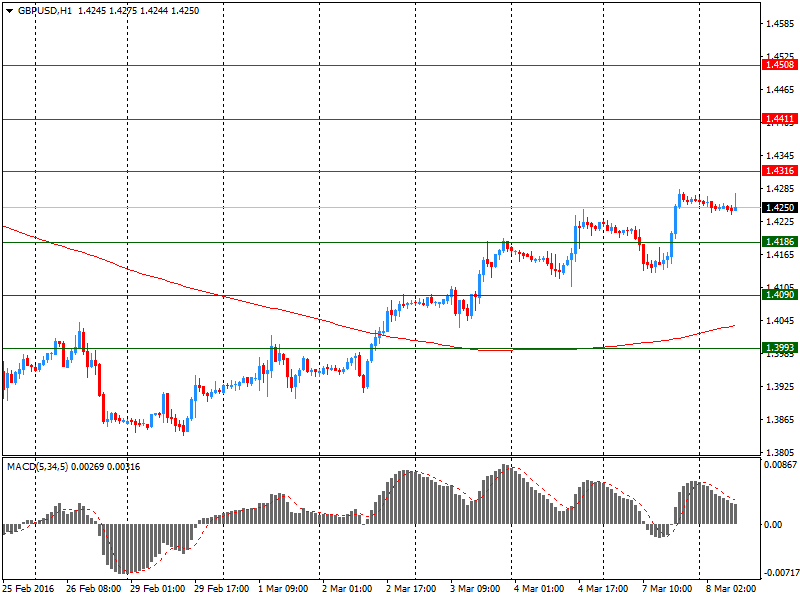
Comments:
- Overall open interest on the CALL options with the expiration date April, 8 is 17374 contracts, with the maximum number of contracts with strike price $1,4700 (2262);
- Overall open interest on the PUT options with the expiration date April, 8 is 16607 contracts, with the maximum number of contracts with strike price $1,3850 (2990);
- The ratio of PUT/CALL was 0.96 versus 0.93 from the previous trading day according to data from March, 7
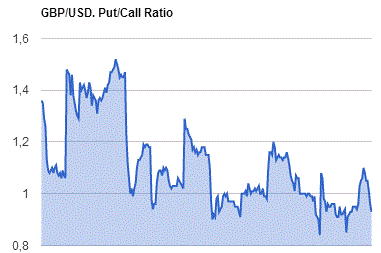
* - The Chicago Mercantile Exchange bulletin (CME) is used for the calculation.
** - Open interest takes into account the total number of option contracts that are open at the moment.
-
08:29
WSE: Pre-Opening
Yesterday's session displayed very clearly different behaviors of stronger stock markets of developing countries (including WSE) against weaker stock markets of developed countries. Today, however, the advantage of the former ones may deteriorate due to weaker economic data from China on trade and the lackluster morning performance of commodities. Similarly, currencies of countries associated with the exports of raw materials, such as Australia, yesterday even gained in value, and today in the morning already corrected. At the moment, it looks like a correction after a strong movement, which in recent days concerned the market for raw materials and all related assets. The correction may reverse during the session, but in the morning it seems that the current sentiment indicates of the former to persist.
Regarding important upcoming events, investors seem to be waiting for the ECB meeting, the BoJ and, most importantly, of the Federal Reserve. From the point of view of the Warsaw Stock Exchange, Thursday's ECB decision is seen mainly in terms of possible risks. This is due to the fact that the Polish market in the past has not shown positive responses to the statements by Mario Draghi. More chances that positive developments will from Fed, which has a more significant impact on the strength of emerging markets.
Domestic market is expected to retain yesterday's behavioral pattern, with the very high closing being in favor of the scenario of today's attack on the level of 1900 points. That can not be ruled out, and the technical analysis indicators seem encouraging. Prevailing morning mood, however, indicates that bullish attitude may not be powerful enough so as to break through the resistance level.
-
08:19
Asian session: Yen rose
Yen rose as Japan's fourth-quarter economic growth was revised up by 0.3 percentage points on Tuesday to a still gloomy annualised pace of -1.1 per cent, as the economy continues to stutter. The weakness of the data raises the pressure on the BoJ to consider further easing as spring wage negotiations reach a climax at the time of its policy meeting next week.
The Australian dollar fell as China's export slump deepened in February, highlighting the challenge for policy makers seeking to keep the economy humming at home while trade acts as a brake on growth. Overseas shipments tumbled 25.4 percent in U.S. dollar terms from a year earlier, the biggest decline since May 2009. Imports extended a streak of declines to 16 months, slumping 13.8 percent, leaving a trade surplus of $32.6 billion. The week-long Chinese new year holidays fell in February this year, closing factories and curbing shipments.
EUR/USD: during the Asian session the pair traded in the range of $1.1010-25
GBP/USD: during the Asian session the pair traded in the range of $1.4240-75
USD/JPY: during the Asian session the pair fell to a Y112.75
-
08:01
Switzerland: Unemployment Rate (non s.a.), February 3.7% (forecast 3.8%)
-
08:00
Germany: Industrial Production s.a. (MoM), January 3.3% (forecast 0.5%)
-
07:29
Global Stocks: European stocks finished lower as gloomy German economic data
European stocks finished lower Monday as gloomy German economic data and a warning about global central bank effectiveness dampened sentiment ahead of the European Central Bank's highly anticipated policy decision later this week.
U.S. stocks eked out small gains Monday, allowing the S&P 500 and Dow industrials to extend their winning streak to five straight sessions, in part thanks to a jump in oil prices.
China shares fell Tuesday and were on track to end a five-day winning streak on worries that the government might try to cool speculative activity in the country's top property markets.
Based on MarketWatch materials
-
06:01
Japan: Consumer Confidence, February 40.1 (forecast 42.3)
-
03:46
China: Trade Balance, bln, February 32.59 (forecast 50.15)
-
03:03
Nikkei 225 16,652.33 -258.99 -1.53 %, Hang Seng 19,988.99 -170.73 -0.85 %, Shanghai Composite 2,886.16 -11.18 -0.39 %
-
01:30
Australia: National Australia Bank's Business Confidence, February 3
-
00:51
Japan: Current Account, bln, January 521 (forecast 719)
-
00:50
Japan: GDP, y/y, Quarter IV -1.1% (forecast -1.5%)
-
00:50
Japan: GDP, q/q, Quarter IV -0.3% (forecast -0.4%)
-
00:31
Commodities. Daily history for Mar 7’2016:
(raw materials / closing price /% change)
Oil 37.98 +0.21%
Gold 1,268.00 +0.32%
-
00:30
Stocks. Daily history for Sep Mar 7’2016:
(index / closing price / change items /% change)
Nikkei 225 16,911.32 -103.46 -0.61 %
Hang Seng 20,159.72 -16.98 -0.08 %
Shanghai Composite 2,898.64 +24.50 +0.85 %
FTSE 100 6,182.4 -17.03 -0.27 %
CAC 40 4,442.29 -14.33 -0.32 %
Xetra DAX 9,778.93 -45.24 -0.46 %
S&P 500 2,001.76 +1.77 +0.09 %
NASDAQ Composite 4,708.25 -8.77 -0.19 %
Dow Jones 17,073.95 +67.18 +0.40 %
-
00:30
Currencies. Daily history for Mar 7’2016:
(pare/closed(GMT +2)/change, %)
EUR/USD $1,1013 +0,11%
GBP/USD $1,4263 +0,29%
USD/CHF Chf0,9952 +0,19%
USD/JPY Y113,45 -0,44%
EUR/JPY Y124,95 -0,32%
GBP/JPY Y162,82 +0,48%
AUD/USD $0,7466 +0,48%
NZD/USD $0,6800 -0,09%
USD/CAD C$1,3280 -0,31%
-
